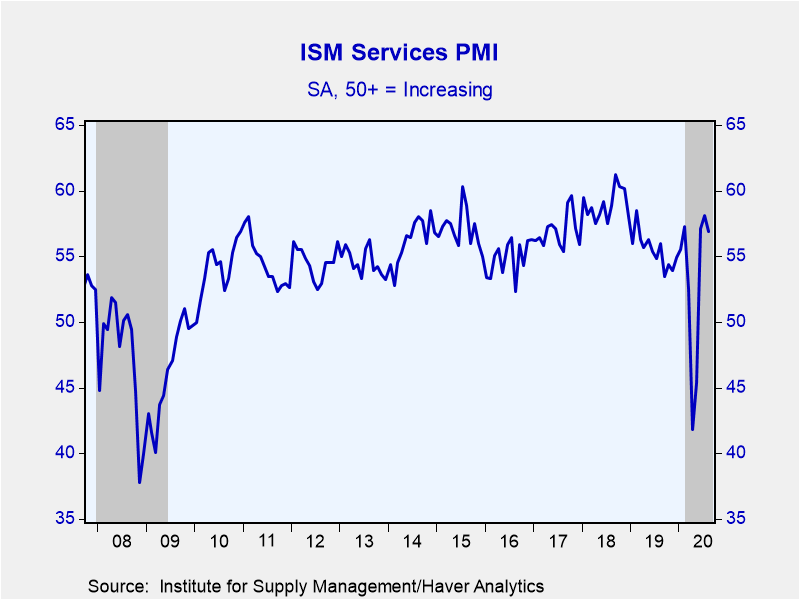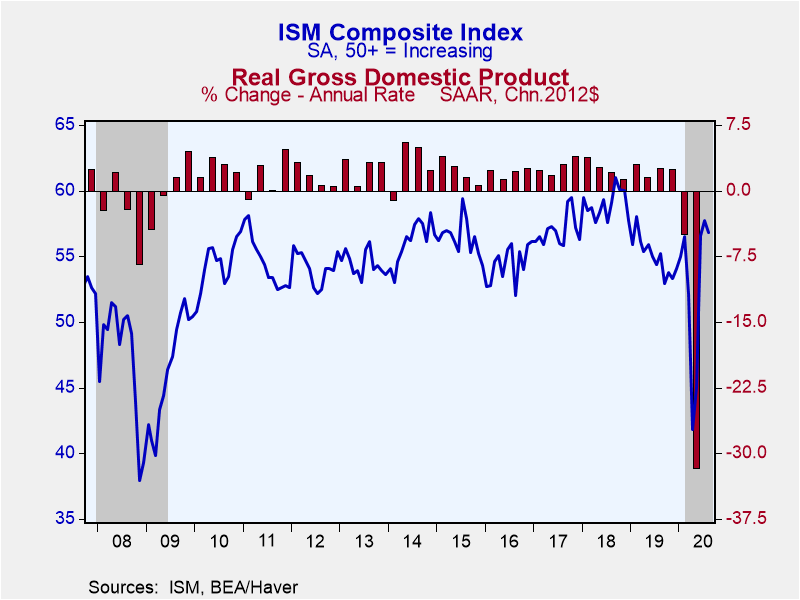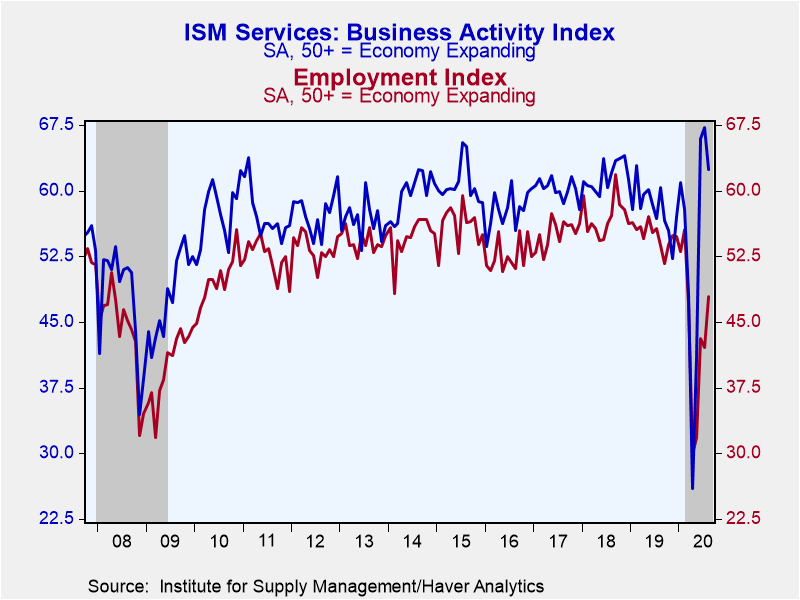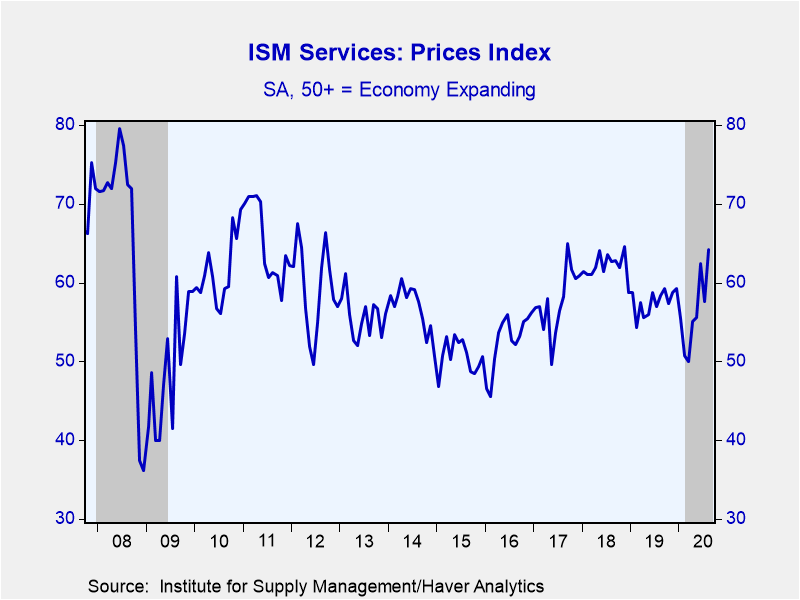 Global| Sep 03 2020
Global| Sep 03 2020U.S. ISM Services Slips in August
by:Tom Moeller
|in:Economy in Brief
Summary
• Though easing slightly, service sector activity remains firm. • Component activity is mixed. • Pricing power strengthens. The Composite Index of Services Activity from the Institute for Supply Management fell to 56.9 during August [...]
• Though easing slightly, service sector activity remains firm.
• Component activity is mixed.
• Pricing power strengthens.
The Composite Index of Services Activity from the Institute for Supply Management fell to 56.9 during August after strengthening to 58.1 in July. A reading of 57.1 had been expected in the Action Economics Forecast Survey.
Haver Analytics constructs a composite index combining the services index and the manufacturing reading which was released on Tuesday. The composite index fell to 56.8 from 57.7. During the last 15 years, there has been a 49% correlation between the index level and the q/q change in real GDP. The composite is based on GDP shares.
Changes in the component series were mixed last month. The index of business activity declined to 62.4 after surging to 67.2 in July. It was the third consecutive reading above the break-even level of 50 after three months below it. A reduced 37% of respondents (NSA) reported improved activity while a steady 15% reported deterioration. The new orders index fell to 56.8 after rising to a record high of 67.7 in July. To the upside, the employment measure rose to 47.9, its highest level in six months. An improved 21% of respondents reported more hiring and a lessened 28% reporting fewer jobs. The supplier delivery series also rose to 60.5 (NSA), indicating slower delivery speeds.
The prices index strengthened to 64.2, the highest level since November 2018 and up from the March 2020 low of 50. An increased 32% of respondents reported higher prices, while a steady six percent reported prices lower. The percentage reporting no change in prices declined sharply to 63%.
The export orders series rebounded to 55.8 and recovered most of July's decline, while the imports index also rose to 50.8. The order backlogs index strengthened to the highest level since September 2018. These series are not seasonally adjusted and are not included in the nonmanufacturing composite.
The ISM figures are available in Haver's USECON database, with additional detail in the SURVEYS database. The expectations figure from Action Economics is in the AS1REPNA database.
| ISM Services Survey (SA) | Aug | Jul | Jun | Aug'19 | 2019 | 2018 | 2017 |
|---|---|---|---|---|---|---|---|
| Services PMI | 56.9 | 58.1 | 57.1 | 56.0 | 55.5 | 59.0 | 56.9 |
| Business Activity | 62.4 | 67.2 | 66.0 | 60.4 | 58.0 | 61.7 | 60.2 |
| New Orders | 56.8 | 67.7 | 61.6 | 59.6 | 57.5 | 61.4 | 59.3 |
| Employment | 47.9 | 42.1 | 43.1 | 53.7 | 54.9 | 56.9 | 55.1 |
| Supplier Deliveries (NSA) | 60.5 | 55.2 | 57.5 | 50.5 | 51.5 | 55.8 | 53.2 |
| Prices Index | 64.2 | 57.6 | 62.4 | 58.4 | 57.6 | 62.1 | 57.7 |
| ISM Manufacturing and Services Composite | 56.8 | 57.7 | 56.6 | 55.2 | 55.0 | 59.0 | 57.0 |
Tom Moeller
AuthorMore in Author Profile »Prior to joining Haver Analytics in 2000, Mr. Moeller worked as the Economist at Chancellor Capital Management from 1985 to 1999. There, he developed comprehensive economic forecasts and interpreted economic data for equity and fixed income portfolio managers. Also at Chancellor, Mr. Moeller worked as an equity analyst and was responsible for researching and rating companies in the economically sensitive automobile and housing industries for investment in Chancellor’s equity portfolio. Prior to joining Chancellor, Mr. Moeller was an Economist at Citibank from 1979 to 1984. He also analyzed pricing behavior in the metals industry for the Council on Wage and Price Stability in Washington, D.C. In 1999, Mr. Moeller received the award for most accurate forecast from the Forecasters' Club of New York. From 1990 to 1992 he was President of the New York Association for Business Economists. Mr. Moeller earned an M.B.A. in Finance from Fordham University, where he graduated in 1987. He holds a Bachelor of Arts in Economics from George Washington University.










